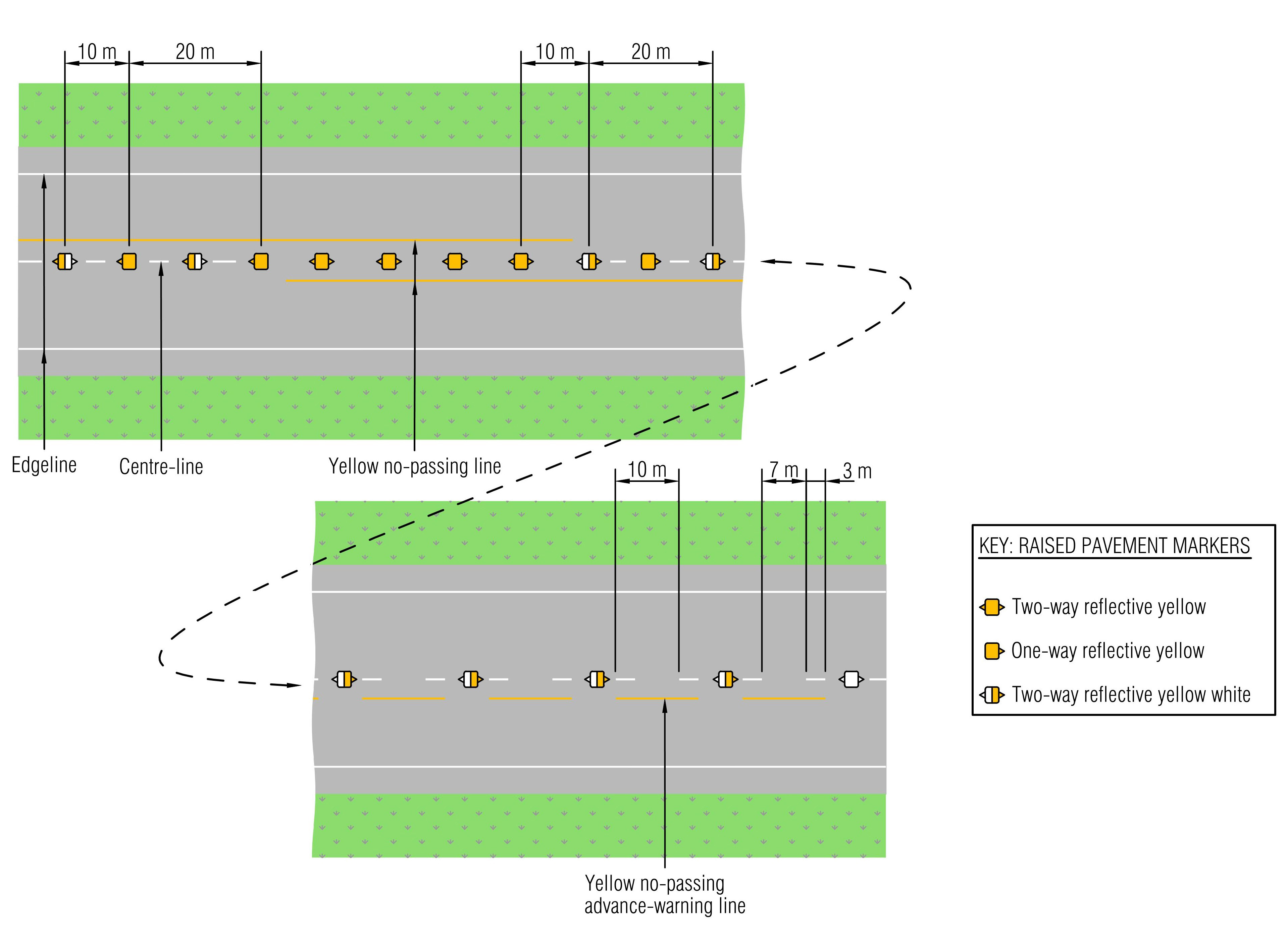No-passing advance-warning lines are used to warn drivers of an overtaking restriction immediately ahead. If practicable, the lines must be marked in advance of all no-passing lines, including those at traffic islands or traffic signals and must be not less than 100mm wide and consisting of a series of yellow dashes, each of which is not longer than 15m, to inform drivers of the existence of the no-passing line ahead.
Marking details are provided in Table 2‑17 and in typical layouts.
Information on the use of RRPMs on no-passing advance-warning lines is provided below.
Table 2‑17: No-passing advance-warning lines marking details
| Application | Rural | Urban |
|---|---|---|
| Colour | Reflectorised yellow | Reflectorised yellow |
| Width | 100mm | 100mm |
| Stripe | 13m (5 stripes) | 13m (3 stripes) |
| Gap | 7m | 7m |
| Location | The advance-warning line should commence
|
The advance-warning line should commence:
|
The arrangement of retroreflective raised pavement markers accompanying advance-warning and no-passing lines in urban and rural areas should use the retroreflective colours as described in Table 2‑18 and as illustrated in Figure 2‑11.
In layouts where a dashed yellow line would warn of an approaching solid yellow line, markers in the dashed section should exhibit a yellow marker body with two-way two-colour, yellow and white retroreflective faces; Category G-Type-3YW markers (refer to raised pavement markers). The yellow face must present to traffic approaching the solid yellow centre-line as shown in Figure 2‑11.
Table 2‑18: No-passing in both direction with advance-warning
| No-passing with advance-warning | ||
|---|---|---|
| Two-way yellow | One-way yellow | Two-way yellow and white |
| Marker Body Colour Y - Yellow |
Marker Body Colour Y – Yellow |
Marker Body colour Y – Yellow |
| Marker Category - G Day/Night retroreflective |
Marker Category - G Day/Night retroreflective |
Marker Category - G Day/Night retroreflective |
| Retroreflective Class Specify Class A, B or C |
Retroreflective Class Specify Class A, B or C |
Retroreflective Class Specify Class A, B or C |
| Marker Type - 2 Two-way one-colour |
Marker Type - 1 One-way one-colour |
Marker Type - 3 Two-way two-colour |
| Retroreflective Colour Y – Yellow |
Retroreflective Colour Y – Yellow |
Retroreflective Colour Y – Yellow and W – White |
| Marker ID Code: G-B2-Y | Marker ID Code: G-B1-Y | Marker ID Code: G-B3-YW |
| Spacing 10m |
Spacing 20m |
Spacing 20m |
| Centrally between the yellow lines | Centrally between every second centre-line dash | Centrally between every alternative centre-line dash |
Figure 2‑11: Two-lane roads, no-passing in both directions with advance-warning lines
View larger image [JPG, 1.5 MB]
No-passing lines are not applicable on raised median divided roads, apart from the approach to traffic islands, medians and physical hazards.
No-passing lines should be marked on the approaches to traffic islands, medians and physical hazards located within the roadway. These lines should terminate to the left side of traffic islands, medians and physical hazards. An exception to this is where tapered flush medians are marked (Table 2‑10).
Refer to features, structures and hazards on, beside or above the roadway for typical details of no-passing line markings in advance of raised traffic islands, physical hazards and medians.
Features, structures and hazards on, beside or above the roadway
Refer to TCD manual Part 9 for typical details of no-passing line markings on the approaches to railway level crossings.